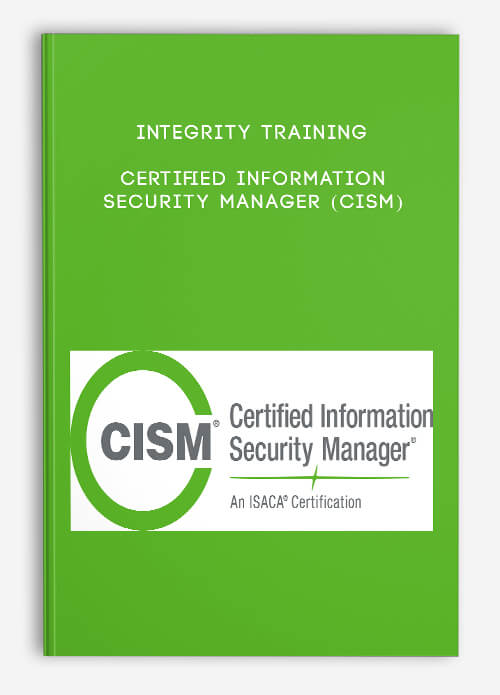Integrity Training – Certified Information Security Manager (CISM)
$199.00 $49.00
Product Include:
File size:
Integrity Training – Certified Information Security Manager (CISM)
**More information:
Get Integrity Training – Certified Information Security Manager (CISM) at Salaedu.com
Description
The Certified Information Security Manager (CISM) course helps the candidates to achieve the CISM certification. The certification is offered by the Information Systems Audit and Control Association (ISACA) to validate the expertise and knowledge of the candidates regarding the relationship between an information security program and the broader business targets. The certification also validates that the candidate has the hands-on knowledge of developing, managing and implementing an information security program for an organization.
CISM certification is a certification by ISACA for experienced Information security management professionals with work experience in developing and managing information security programs. The CISM course covers the four domains of the CISM certification exam. The course is an ideal preparatory course for the students seeking to gain CISM certification as well as the IT security and information security professionals looking to build on their practical experience.
Prerequisites:
- As the case with the CISM certification exam, the candidates are required to have a minimum of five years of experience in information security management.
Student Materials:
Student Workbook
Student Prep Guide
Certification Exams:
Certified Information Security Manager
Who Should Attend?
- Experienced information security managers and officers
- IT consultants and managers
- IT auditors
- IT security policy makers
- Privacy officers
- Network administrators
- Network security engineers
- Candidates seeking CISM certificatio
Course Curriculum
Course Introduction
StartIntroduction (0:10)
StartCourseI Introduction (1:02)
StartInstructor Introduction (1:20)
Information Security Governance
StartLesson 1: Information Security Governance Overview (0:53)
StartInformation Security Governance Overview Part1 (1:12)
StartInformation Security Governance Overview Part2 (2:00)
StartInformation Security Governance Overview Part3 (1:22)
StartInformation Security Governance Overview Part4 (1:32)
StartInformation Security Governance Overview Part5 (0:29)
StartImportance of Information Security Governance Part1 (1:18)
StartImportance of Information Security Governance Part2 (6:20)
StartOutcomes of Information Security Governance Part1 (0:33)
StartOutcomes of Information Security Governance Part2 (1:26)
StartOutcomes of Information Security Governance Part3 (2:45)
StartOutcomes of Information Security Governance Part4 (1:27)
StartOutcomes of Information Security Governance Part5 (1:54)
StartOutcomes of Information Security Governance Part6 (1:28)
StartLesson 2: Effective Information Security Governance (0:31)
StartBusiness Goals and Objectives Part1 (1:31)
StartBusiness Goals and Objectives Part2 (2:00)
StartRoles and Responsibilities of Senior Management Part1 (1:02)
StartRoles and Responsibilities of Senior Management Part2 (0:43)
StartDomain Tasks Part1 (1:21)
StartDomain Tasks Part2 (3:16)
StartBusiness Model for Information Security Part1 (0:45)
StartBusiness Model for Information Security Part2 (1:09)
StartBusiness Model for Information Security Part3 (3:16)
StartBusiness Model for Information Security Part4 (1:37)
StartDynamic Interconnections Part1 (0:34)
StartDynamic Interconnections Part2 (2:55)
StartDynamic Interconnections Part3 (1:55)
StartDynamic Interconnections Part4 (0:51)
StartLesson 3: Information Security Concepts and Technologies (3:26)
StartInformation Security Concepts and Technologies Part1 (2:58)
StartInformation Security Concepts and Technologies Part2 (3:25)
StartInformation Security Concepts and Technologies Part3 (1:50)
StartTechnologies Part1 (1:41)
StartTechnologies Part2 (6:12)
StartLesson 4: Information Security Manager (0:33)
StartResponsibilities (1:48)
StartSenior Management Commitment Part1 (0:48)
StartSenior Management Commitment Part2 (2:27)
StartObtaining Senior Management Commitment Part1 (0:24)
StartObtaining Senior Management Commitment Part2 (0:53)
StartEstablishing Reporting and Communication Channels Part1 (1:13)
StartEstablishing Reporting and Communication Channels Part2 (1:07)
StartLesson 5: Scope and Charter of Information Security Governance (1:55)
StartAssurance Process Integration and Convergence (2:24)
StartConvergence (2:32)
StartGovernance and Third-Party Relationships (2:38)
StartLesson 6: Information Security Governance Metrics (0:56)
StartMetrics (1:38)
StartEffective Security Metrics Part1 (1:46)
StartEffective Security Metrics Part2 (1:01)
StartEffective Security Metrics Part3 (1:51)
StartEffective Security Metrics Part4 (0:39)
StartSecurity Implementation Metrics (1:17)
StartStrategic Alignment Part1 (2:56)
StartStrategic Alignment Part2 (1:10)
StartRisk Management (1:14)
StartValue Delivery (1:01)
StartResource Management Part1 (0:47)
StartResource Management Part2 (0:41)
StartPerformance Measurement (3:06)
StartAssurance Process Integration/Convergence (2:54)
StartLesson 7: Information Security Strategy Overview (0:53)
StartAnother View of Strategy (0:41)
StartLesson 8: Creating Information Security Strategy (0:16)
StartInformation Security Strategy (1:22)
StartCommon Pitfalls Part1 (4:38)
StartCommon Pitfalls Part2 (2:19)
StartObjectives of the Information Security Strategy (1:33)
StartWhat is the Goal? (1:40)
StartDefining Objectives (1:22)
StartBusiness Linkages (1:48)
StartBusiness Case Development Part1 (1:43)
StartBusiness Case Development Part2 (2:36)
StartBusiness Case Development Part3 (0:45)
StartBusiness Case Objectives (0:57)
StartThe Desired State (1:48)
StartCOBIT (1:08)
StartCOBIT Controls (1:09)
StartCOBIT Framework (0:48)
StartCapability Maturity Model (1:38)
StartBalanced Scorecard (1:22)
StartArchitectural Approaches (1:03)
StartISO/IEC 27001 and 27002 (0:59)
StartRisk Objectives Part1 (1:38)
StartRisk Objectives Part2 (3:11)
StartLesson 9: Determining Current State Of Security (0:45)
StartCurrent Risk Part1 (2:37)
StartCurrent Risk Part2 (1:11)
StartBIA (1:11)
StartLesson 10: Information Security Strategy Development (1:52)
StartThe Roadmap (1:01)
StartElements of a Strategy (3:27)
StartStrategy Resources and Constraints (2:45)
StartLesson 11: Strategy Resources (0:32)
StartPolicies and Standards (1:00)
StartDefinitions (5:48)
StartEnterprise Information Security Architectures (1:30)
StartControls (3:00)
StartCountermeasures (0:55)
StartTechnologies (1:50)
StartPersonnel (1:54)
StartOrganizational Structure (3:47)
StartEmployee Roles and Responsibilities (0:28)
StartSkills (1:16)
StartAudits (1:41)
StartCompliance Enforcement (2:24)
StartThreat Assessment (1:41)
StartVulnerability Assessment (2:21)
StartRisk Assessment (2:19)
StartInsurance (2:04)
StartBusiness Impact Assessment (2:32)
StartOutsourced Security Providers (2:57)
StartLesson 12: Strategy Constraints (0:22)
StartLegal and Regulatory Requirements (1:42)
StartPhysical Constraints (2:56)
StartThe Security Strategy (1:35)
StartLesson 13: Action Plan to Implement Strategy (1:13)
StartGap Analysis Part1 (1:35)
StartGap Analysis Part2 (0:52)
StartGap Analysis Part3 (3:01)
StartPolicy Development Part1 (1:41)
StartPolicy Development Part2 (1:00)
StartStandards Development (2:44)
StartTraining and Awareness (0:35)
StartAction Plan Metrics (1:23)
StartGeneral Metric Considerations Part1 (0:23)
StartGeneral Metric Considerations Part2 (0:35)
StartGeneral Metric Considerations Part3 (0:42)
StartGeneral Metric Considerations Part4 (0:23)
StartCMM4 Statements (2:00)
StartObjectives for CMM4 (0:47)
StartSection Review (0:44)
StartReview Questions
Information Risk Management
StartLesson 1: Risk Management Overview (0:59)
StartRisk Management Overview (1:51)
StartTypes of Risk Analysis (7:08)
StartThe Importance of Risk Management (2:14)
StartRisk Management Outcomes (1:34)
StartRisk Management Strategy (1:49)
StartLesson 2: Good Information Security Risk Management (4:14)
StartContext and Purpose (3:08)
StartScope and Charter (0:38)
StartAssets (2:31)
StartOther Risk Management Goals (2:02)
StartRoles and Responsibilities (2:51)
StartLesson 3: Information Security Risk Management Concepts (6:06)
StartTechnologies (6:39)
StartLesson 4: Implementing Risk Management (2:08)
StartThe Risk Management Framework (2:00)
StartThe External Environment (1:48)
StartThe Internal Environment (2:06)
StartThe Risk Management Context (0:47)
StartGap Analysis (2:21)
StartOther Organizational Support (4:09)
StartRisk Analysis (1:22)
StartLesson 5: Risk Assessment (1:19)
StartNIST Risk Assessment Methodology (3:49)
StartAggregated or Cascading Risk (2:54)
StartOther Risk Assessment Approaches (1:18)
StartIdentification of Risks (1:48)
StartThreats (1:08)
StartVulnerabilities Part1 (2:11)
StartVulnerabilities Part2 (4:10)
StartRisks (1:35)
StartAnalysis of Relevant Risks (1:48)
StartRisk Analysis (2:29)
StartSemi -Quantitative Analysis (1:51)
StartQuantitative Analysis Example (4:14)
StartEvaluation of Risks (0:46)
StartRisk Treatment Options (4:39)
StartImpact (2:59)
StartLesson 6: Controls Countermeasures (0:25)
StartControls (4:43)
StartResidual Risk (3:38)
StartInformation Resource Valuation (1:33)
StartMethods of Valuing Assets (1:36)
StartInformation Asset Classification (3:32)
StartDetermining Classification (2:05)
StartImpact Part1 (3:53)
StartImpact Part2 (1:03)
StartLesson 7: Recovery Time Objectives (0:49)
StartRecovery Point Objectives (4:18)
StartService Delivery Objectives (1:58)
StartThird-Party Service Providers (1:43)
StartWorking with Lifecycle Processes (2:08)
StartIT System Development (2:11)
StartProject Management Part1 (0:46)
StartProject Management Part2 (2:10)
StartLesson 8: Risk Monitoring and Communication (1:17)
StartRisk Monitoring and Communication (0:38)
StartOther Communications (1:25)
StartSection Review (1:01)
StartReview Questions
Information Security Program Development
StartIntroduction (0:30)
StartLesson 1: Development of Information Security Program (2:50)
StartImportance of the Program (0:52)
StartOutcomes of Security Program Development (1:47)
StartEffective Information Security Program Development (4:59)
StartLesson 2: Information Security Program Objectives (1:55)
StartCross Organizational Responsibilities (0:10)
StartProgram Objectives Part1 (2:22)
StartProgram Objectives Part2 (1:18)
StartDefining Objectives Part1 (2:10)
StartDefining Objectives Part2 (1:08)
StartLesson 3: Information Security Program Development Concepts Part1 (4:02)
StartInformation Security Program Development Concepts Part2 (5:39)
StartTechnology Resources (2:44)
StartInformation Security Manager (1:25)
StartLesson 4: Scope and Charter of Information Security Program Development (0:29)
StartAssurance Function Integration (1:35)
StartChallenges in Developing Information Security Program (1:54)
StartPitfalls (2:48)
StartObjectives of the Security Program (2:06)
StartProgram Goals (2:52)
StartThe Steps of the Security Program (1:46)
StartDefining the Roadmap Part1 (1:37)
StartDefining the Roadmap Part2 (0:58)
StartElements of the Roadmap Part1 (1:18)
StartElements of the Roadmap Part2 (0:34)
StartElements of the Roadmap Part3 (1:57)
StartElements of the Roadmap Part4 (1:17)
StartElements of the Roadmap Part5 (0:18)
StartGap Analysis (0:44)
StartLesson 5: Information Security Management Framework (0:15)
StartSecurity Management Framework (4:55)
StartCOBIT 5 (5:59)
StartISO/IEC 27001 (4:30)
StartLesson 6: Information Security Framework Components (0:13)
StartOperational Components Part1 (1:56)
StartOperational Components Part2 (3:11)
StartManagement Components (1:30)
StartAdministrative Components (3:29)
StartEducational and Informational Components (1:25)
StartLesson 7: Information Security Program Resources (1:32)
StartResources (3:27)
StartDocumentation (0:54)
StartEnterprise Architecture Part1 (4:29)
StartEnterprise Architecture Part2 (1:54)
StartEnterprise Architecture Part3 (1:11)
StartControls as Strategy Implementation Resources Part1 (3:42)
StartControls as Strategy Implementation Resources Part2 (2:19)
StartControls as Strategy Implementation Resources Part3 (4:35)
StartControls as Strategy Implementation Resources Part4 (2:19)
StartCommon Control Practices (1:41)
StartCountermeasures (0:37)
StartTechnologies Part1 (1:13)
StartTechnologies Part2 (1:52)
StartTechnologies Part3 (1:39)
StartTechnologies Part4 (5:38)
StartPersonnel Part1 (2:00)
StartPersonnel Part2 (2:56)
StartSecurity Awareness (1:28)
StartAwareness Topics (5:18)
StartFormal Audits (1:16)
StartCompliance Enforcement (1:03)
StartProject Risk Analysis (3:09)
StartOther Actions (2:58)
StartOther Organizational Support (1:21)
StartProgram Budgeting Part1 (1:03)
StartProgram Budgeting Part2 (2:19)
StartLesson 8: Implementing an Information Security Program (0:13)
StartPolicy Compliance (2:38)
StartStandards Compliance (2:44)
StartTraining and Education (1:43)
StartISACA Control Objectives (3:52)
StartThird-party Service Providers Part1 (1:08)
StartThird-party Service Providers Part2 (4:22)
StartIntegration into Lifecycle Processes (2:14)
StartMonitoring and Communication (3:33)
StartDocumentation (1:32)
StartThe Plan of Action Part1 (1:16)
StartThe Plan of Action Part2 (1:36)
StartLesson 9: Information Infrastructure and Architecture (0:53)
StartManaging Complexity Part1 (4:42)
StartManaging Complexity Part2 (1:45)
StartObjectives of Information Security Architectures Part1 (1:30)
StartObjectives of Information Security Architectures Part2 (1:15)
StartPhysical and Environmental Controls (3:32)
StartLesson 10: Information Security Program (3:03)
StartInformation Security Program Deployment Metrics (2:27)
StartMetrics (2:02)
StartStrategic Alignment (0:53)
StartRisk Management (1:40)
StartValue Delivery (0:35)
StartResource Management (1:22)
StartAssurance Process Integration (0:27)
StartPerformance Measurement (0:40)
StartSecurity Baselines (0:38)
StartLesson 11: Security Program Services and Operational Activities (0:48)
StartIS Liaison Responsibilities Part1 (10:17)
StartIS Liaison Responsibilities Part2 (2:28)
StartCross-Organizational Responsibilities (1:33)
StartSecurity Reviews and Audits Part1 (3:27)
StartSecurity Reviews and Audits Part2 (1:38)
StartManagement of Security Technology (1:25)
StartDue Diligence Part1 (4:10)
StartDue Diligence Part2 (1:36)
StartCompliance Monitoring and Enforcement Part1 (2:02)
StartCompliance Monitoring and Enforcement Part2 (1:46)
StartAssessment of Risk and Impact Part1 (2:16)
StartAssessment of Risk and Impact Part2 (1:28)
StartOutsourcing and Service Providers (2:33)
StartCloud Computing Part1 (1:36)
StartCloud Computing Part2 (1:54)
StartCloud Computing Part3 (2:23)
StartIntegration with IT Processes (0:42)
StartSection Review (1:13)
StartReview Questions
Information Security Incident Management
StartLesson 1: Incident Management Overview Part1 (0:47)
StartIncident Management Overview Part2 (3:08)
StartIncident Management Overview Part3 (3:45)
StartTypes of Events Part1 (2:43)
StartTypes of Events Part2 (3:20)
StartGoals of Incident Management Part1 (4:45)
StartGoals of Incident Management Part2 (6:31)
StartGoals of Incident Management Part3 (3:26)
StartLesson 2: Incident Response Procedures Part1 (0:23)
StartIncident Response Procedures Part2 (3:40)
StartImportance of Incident Management (8:00)
StartOutcomes of Incident Management (3:50)
StartIncident Management (1:34)
StartConcepts Part1 (3:44)
StartConcepts Part2 (1:35)
StartConcepts Part3 (1:34)
StartIncident Management Systems Part1 (4:01)
StartIncident Management Systems Part2 (0:53)
StartLesson 3: Incident Management Organization (2:30)
StartResponsibilities Part1 (3:44)
StartResponsibilities Part2 (2:58)
StartResponsibilities Part3 (5:10)
StartSenior Management Commitment (1:02)
StartLesson 4: Incident Management Resources (0:25)
StartPolicies and Standards (0:36)
StartIncident Response Technology Concepts (11:11)
StartPersonnel (8:24)
StartRoles and Responsibilities (eNotes) (3:11)
StartSkills (8:09)
StartAwareness and Education (1:20)
StartAudits (2:49)
StartLesson 5: Incident Management Objectives (0:17)
StartDefining Objectives (0:47)
StartThe Desired State (3:29)
StartStrategic Alignment (6:42)
StartOther Concerns (2:32)
StartLesson 6: Incident Management Metrics and Indicators (5:13)
StartImplementation of the Security Program Management (3:01)
StartManagement Metrics and Monitoring Part1 (1:35)
StartManagement Metrics and Monitoring Part2 (2:48)
StartOther Security Monitoring Efforts (4:24)
StartLesson 7: Current State of Incident Response Capability (0:11)
StartThreats (4:39)
StartVulnerabilities (6:15)
StartLesson 8: Developing an Incident Response Plan (0:44)
StartElements of an Incident Response Plan (8:19)
StartGap Analysis (3:05)
StartBIA Part1 (5:05)
StartBIA Part2 (2:48)
StartEscalation Process for Effective IM (2:45)
StartHelp Desk Processes for Identifying Security Incidents (1:27)
StartIncident Management and Response Teams (2:10)
StartOrganizing, Training, and Equipping the Response Staff (1:54)
StartIncident Notification Process (0:54)
StartChallenges in making an Incident Management Plan (2:18)
StartLesson 9: BCP/DRP (7:49)
StartGoals of Recovery Operations Part1 (2:02)
StartGoals of Recovery Operations Part2 (1:57)
StartChoosing a Site Selection Part1 (5:37)
StartChoosing a Site Selection Part2 (1:18)
StartImplementing the Strategy (3:58)
StartIncident Management Response Teams (2:10)
StartNetwork Service High-availability (4:17)
StartStorage High-availability (4:01)
StartRisk Transference (1:27)
StartOther Response Recovery Plan Options (1:29)
StartLesson 10: Testing Response and Recovery Plans (2:17)
StartPeriodic Testing (1:17)
StartAnalyzing Test Results Part1 (2:06)
StartAnalyzing Test Results Part2 (3:39)
StartMeasuring the Test Results (0:57)
StartLesson 11: Executing the Plan (1:56)
StartUpdating the Plan (1:15)
StartIntrusion Detection Policies (1:38)
StartWho to Notify about an Incident (1:52)
StartRecovery Operations (1:53)
StartOther Recovery Operations (1:57)
StartForensic Investigation (3:05)
StartHacker / Penetration Methodology (11:50)
StartSection Review (1:15)
StartReview Questions
StartCourse Closure (1:53)
Forex Trading – Foreign Exchange Course
Want to learn about Forex?
Foreign exchange, or forex, is the conversion of one country’s currency into another.
In a free economy, a country’s currency is valued according to the laws of supply and demand.
In other words, a currency’s value can be pegged to another country’s currency, such as the U.S. dollar, or even to a basket of currencies.
A country’s currency value may also be set by the country’s government.
However, most countries float their currencies freely against those of other countries, which keeps them in constant fluctuation.
1 review for Integrity Training – Certified Information Security Manager (CISM)
Add a review Cancel reply
Related products
Forex - Trading & Investment
Forex - Trading & Investment
Forex - Trading & Investment
Michael Parsons – Channel Surfing Video Course (Manual,Video)
Forex - Trading & Investment
Forex - Trading & Investment
Paul Lemal – Bottom Springers. Bonsai Elite WaveTrader Course (8 DVDs & Manuals)
Forex - Trading & Investment
Pristine – Oliver Velez & Greg Capra – Trading the Pristine Method. The Refresher Course – I & II











king –
We encourage you to check Content Proof carefully before paying.“Excepted” these contents: “Online coaching, Software, Facebook group, Skype and Email support from Author.”If you have enough money and feel good. We encourage you to buy this product from the original Author to get full other “Excepted” contents from them.Thank you!